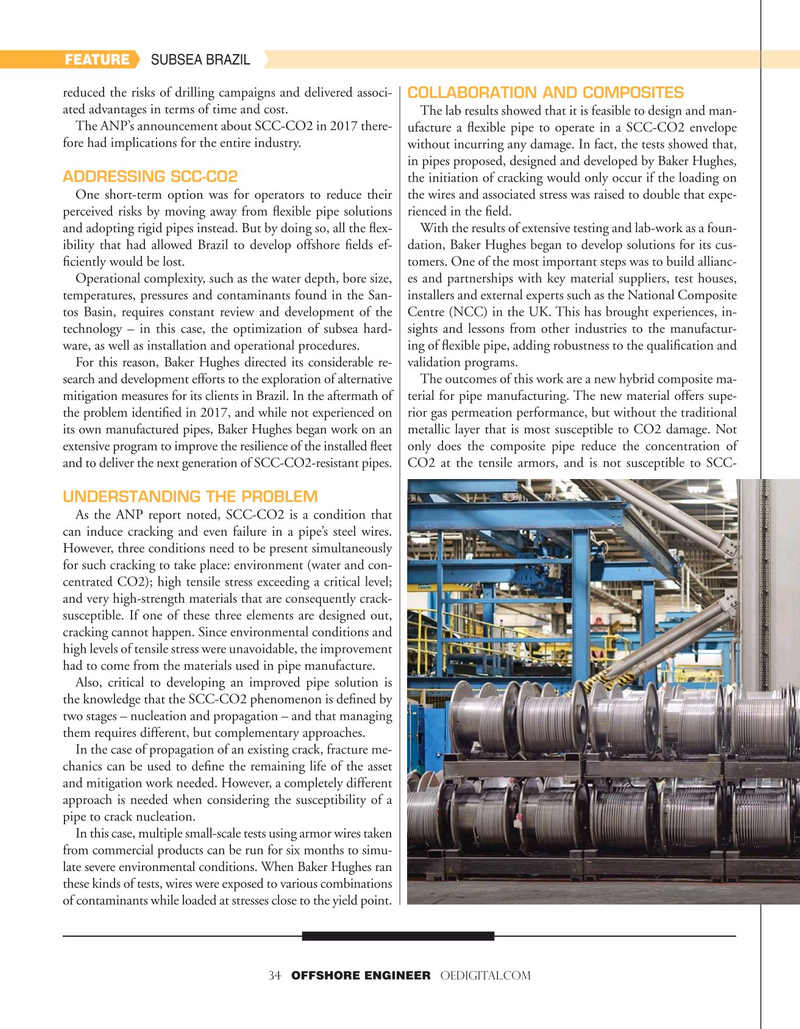
Page 34: of Offshore Engineer Magazine (Nov/Dec 2020)
Read this page in Pdf, Flash or Html5 edition of Nov/Dec 2020 Offshore Engineer Magazine
FEATURE SUBSEA BRAZIL reduced the risks of drilling campaigns and delivered associ-
COLLABORATION AND COMPOSITES ated advantages in terms of time and cost.
The lab results showed that it is feasible to design and man-
The ANP’s announcement about SCC-CO2 in 2017 there- ufacture a ?exible pipe to operate in a SCC-CO2 envelope fore had implications for the entire industry. without incurring any damage. In fact, the tests showed that, in pipes proposed, designed and developed by Baker Hughes, the initiation of cracking would only occur if the loading on
ADDRESSING SCC-CO2
One short-term option was for operators to reduce their the wires and associated stress was raised to double that expe- perceived risks by moving away from ?exible pipe solutions rienced in the ?eld.
and adopting rigid pipes instead. But by doing so, all the ?ex- With the results of extensive testing and lab-work as a foun- ibility that had allowed Brazil to develop offshore ?elds ef- dation, Baker Hughes began to develop solutions for its cus- ?ciently would be lost. tomers. One of the most important steps was to build allianc-
Operational complexity, such as the water depth, bore size, es and partnerships with key material suppliers, test houses, temperatures, pressures and contaminants found in the San- installers and external experts such as the National Composite tos Basin, requires constant review and development of the Centre (NCC) in the UK. This has brought experiences, in- technology – in this case, the optimization of subsea hard- sights and lessons from other industries to the manufactur- ware, as well as installation and operational procedures. ing of ?exible pipe, adding robustness to the quali?cation and
For this reason, Baker Hughes directed its considerable re- validation programs.
search and development efforts to the exploration of alternative The outcomes of this work are a new hybrid composite ma- mitigation measures for its clients in Brazil. In the aftermath of terial for pipe manufacturing. The new material offers supe- the problem identi?ed in 2017, and while not experienced on rior gas permeation performance, but without the traditional its own manufactured pipes, Baker Hughes began work on an metallic layer that is most susceptible to CO2 damage. Not extensive program to improve the resilience of the installed ?eet only does the composite pipe reduce the concentration of and to deliver the next generation of SCC-CO2-resistant pipes. CO2 at the tensile armors, and is not susceptible to SCC-
UNDERSTANDING THE PROBLEM
As the ANP report noted, SCC-CO2 is a condition that can induce cracking and even failure in a pipe’s steel wires.
However, three conditions need to be present simultaneously for such cracking to take place: environment (water and con- centrated CO2); high tensile stress exceeding a critical level; and very high-strength materials that are consequently crack- susceptible. If one of these three elements are designed out, cracking cannot happen. Since environmental conditions and high levels of tensile stress were unavoidable, the improvement had to come from the materials used in pipe manufacture.
Also, critical to developing an improved pipe solution is the knowledge that the SCC-CO2 phenomenon is de?ned by two stages – nucleation and propagation – and that managing them requires different, but complementary approaches.
In the case of propagation of an existing crack, fracture me- chanics can be used to de?ne the remaining life of the asset and mitigation work needed. However, a completely different approach is needed when considering the susceptibility of a pipe to crack nucleation.
In this case, multiple small-scale tests using armor wires taken from commercial products can be run for six months to simu- late severe environmental conditions. When Baker Hughes ran these kinds of tests, wires were exposed to various combinations of contaminants while loaded at stresses close to the yield point. 34 OFFSHORE ENGINEER OEDIGITAL.COM

 33
33

 35
35